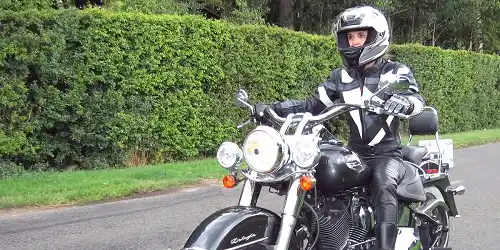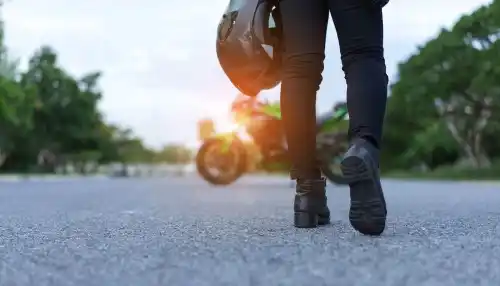Book a motorcycle test in Langdon Hills, Essex with any of the companies listed here
Click on any of the motorcycle training schools below to view more information and check availability.
ART Rider Training Basildon
Unit L Wrexham Road, Basildon, Essex, SS15 6PX
Approx. distance: 0.5 miles
C View Motorcycle Training Essex
Bromfords School, Grange Avenue, Wickford, Essex, SS12 0LZ
Approx. distance: 4.8 miles
Edventure Rider Chafford Hundred
Fleming Road, Chafford Hundred, Grays, Thurrock, RM16 6YJ
Approx. distance: 7.5 miles
Edventure Rider West Thurrock
Edventure Rider, 560 London Road, West Thurrock, Essex, RM20 3BJ
Approx. distance: 8.6 miles
Ride Motorcycle Training Romford
The Car Drome, Upper Rainham Road, Hornchurch, RM12 4EU
Approx. distance: 10.1 miles
Probike Training Chelmsford
3 Russell Way, Chelmsford, Essex, CM1 3AA
Approx. distance: 11.2 miles
CSN Training Kent
Riverside 3 Car Park, Sir Thomas Longley Rd, Rochester, Kent, ME2 4SQ
Approx. distance: 12.6 miles
Universal Motorcycle Training Dagenham
Goals Dagenham, Ripple Road, Dagenham, Greater London, RM9 6XW
Approx. distance: 12.7 miles
SL Motorcycle Training Dagenham
Barking Rugby Union Football Club, Dagenham, London, RM9 4TX
Approx. distance: 12.9 miles
Pass Bike Motorcycle Training Southend
Yard 2, 8 Purdeys Way, Rochford, Essex, SS4 1NE
Approx. distance: 12.9 miles

Looking for a motorcycle test in Langdon Hills, Essex?
Have you been looking to book motorcycle training in Langdon Hills? Then Book CBT Now is the place you need to be. We are a highly-experienced team who have sourced the best companies for motorcycle training and testing for over 19 years and can ensure that you are always working with qualified professionals who can help with all of your training and tests. We are happy to suggest various other companies across Essex for your test or in the surrounding areas of Laindon, Basildon and Corringham.
What are the different types of motorcycle licence I can get in Langdon Hills?
There are 4 main types of full motorcycle licence issued by the DVSA. The first three (AM, A1 and A2 motorcycle licences) have restrictions on the type of moped or motorcycle you can ride, the fourth (the full A motorcycle licence) has no restrictions.
The AM restricted moped licence
The A1 restricted motorcycle licence
The minimum age to take this test is 17. According to the DVSA website it will allow you to ride a "Light motorcycle up to 11 kW (and a power-to-weight ratio not more than 0.1 kW per kg) and 125 cc". This means it's up to a 125 cc motorcycle with some restrictions to make sure it cannot accelerate too fast - a really good idea when you are new to riding a motorbike!
Requirements to take the A1 motorcycle test - You must have a UK provisional or full driving licence, a valid theory test certificate and a valid CBT certificate. Once you have taken this test you will not have to keep renewing your CBT certificate every 2 years, you can ride on motorways and you can take a pillion passenger on the back of your motorbike.
The A2 restricted motorcycle licence
For this licence you need to be at least 19 years of age, have completed your CBT or have had an A1 licence for at least 2 years. As with the A1 test you also need to have a UK provisional or full driving licence and a valid theory test certificate . The main benefit of getting an A2 licence is you can ride a more powerful motorcycle. The law states a "standard motorcycle up to 35 kW (and a power-to-weight ratio not more than 0.2 kW per kg)". So it's a more powerful bike, but still not completely un-restricted. To find A2 legal motorbikes you are best visiting your local motorcycle dealer and asking them to show you the A2 legal bikes, as otherwise it's very difficult to work out just looking at the tech specs.
The full A motorcycle licence, or DAS licence.
This is the licence that allows you to ride almost any motorcycle without restrictions, so it's the ultimate motorcycle licence. No limits on power outputs or power per kg or engine size! It is also called a 'DAS' licence as it can be obtained from the 'Direct AccesS' route. There are two ways you can get this licence:
1) If you are 24 or over you can take the tests for an A licence. You must also have a UK provisional or full driving licence, a valid theory test certificate and a valid CBT certificate.
2) If you are at least 21 years of age and you have held an A2 category licence for at least 2 years. This is sometimes referred to as the 'progressive access' route as you progress from one licence to another.
When taking the test the biggest difference is that you have to use a bigger, more powerful motorcycle. It will have a power of at least 40kw and an engine cc of at least 595 cc. Your local training school will make sure you have the right size bike for your test.
There is also a flowchart (click here) that the DVLA have produced that shows these different licences and how to obtain them.
To get more detailed guidance on what licence is right for you then talk to your local motorcycle training school. You can search for them here and they are qualified to speak to you on the right type of training for you.
What can I ride on a provisional driving licence in Langdon Hills?
A provisional driving licence is not a full driving licence so you are limited in what you can ride. So, when you first come to ride a motorcycle the DVSA will issue you with a provisional driving licence. What you can ride will depend on your age.
Age 16
You must complete a CBT and then you can ride a moped or scooter up to 50 cc and with a top speed of no more than 28 mph. You must display L plates, you cannot carry a pillion passenger and you must not ride on a motorway.
Age 17 or over
You must complete a CBT and then you can ride a restricted motorcycle up to 125 cc. You must display L plates, you cannot carry a pillion passenger and you must not ride on a motorway.
Do you have a full car driving licence?
If you already have a full car driving licence then this automatically gives you provisional entitlement for riding a motorcycle. So, priovided you get your CBT certificate then you can ride a moped or motorcycle as mentioned above according to your age.

If I have a full car driving licence what motorcycle can I ride?
This depends on when you passed your driving test:
If you passed your car driving test before 1st February 2001
In this case you can ride a moped up to 50 cc without Learner plates and without needing a CBT. If you want to ride anything bigger then you will need to get your CBT certificate. Then you will be able to ride a restricted motorcycle up to 125 cc with Learner plates displayed.
If you passed your driving test on or after 1st February 2001
You must obtain a CBT certificate before you can ride anything. Once completed you can ride a moped or restricted motorcycle up to 125 cc.
How do I get the right training in Langdon Hills for the A1 motorcycle licence?
The A1 motorcycle licence is a restricted licence you can get when you are 17 or over. It is popular amongst 17 to 19 year olds as it is the only licence that allows you to get on a more powerful motorcycle at that age. It is essential that you get the right training for this licence as without it you are likely to hurt yourself or even worse, someone else. Use this website to enter your postcode and search for your local motorcycle training school. They are all fully qualified to advise you on the training you will need. Although saving money is something everyone wants to do, the right training will save your life. Therefore don't just focus on price, look at the quality of training on offer and the standard of training.